Fundamentals to Keep In Mind When Healthcare Blogging
By understanding a few fundamental tips and strategies before you get started, you’re already ahead of most bloggers and setting your organization up to increase your website traffic. Here are some fundamentals to keep in mind when healthcare blogging.

There are 600 million blogs that exist on the internet.
That much content would take the average user a lifetime to read through. Even if they attempted to, the majority of the information they read wouldn’t interest them.
There are multiple reasons why so many blogs exist. Some of them are personal memoirs or diaries, others provide helpful “How To” information on different tasks, and a few are entirely devoted to providing cat pictures.
But blogs aren’t only limited to the everyday person writing them. Marketers at B2C and B2B organizations understand the opportunity blogging provides for them. In fact, companies that create this form of content generate 55% more visits to their website than those that don’t.

The best part is that providing written content on your website and posting it publicly on the internet doesn’t have any upfront costs. The only thing you’re paying with is time.
OK, but you’re a healthcare provider, practice, or organization. Do people really want to read content about providing health tips or first-hand accounts from doctors? Simply put, yes.
6 million US internet users search for health-related information on their favorite search engine every day.
Imagine if you could attract even just a fraction of that much traffic. It’d not only help establish your organization as a leading expert within the healthcare space, you’d increase your patient volume.
Even though there are already so many blogs on the internet, don’t let the saturation discourage you. By understanding a few fundamental tips and strategies before you get started, you’re already ahead of most bloggers and setting your organization up to increase your website traffic.
Here are some fundamentals to keep in mind when healthcare blogging.
Give Accurate Information
As a healthcare professional, you know about some of the most helpful information on the planet.
Whether you’re a specialty doctor, know about a particular treatment plan, or work through a complex process like medical coding...you’re an expert.
After you read the title of this section you might’ve questioned it, “Of course I’m going to give accurate information. How is this helpful?”
Well, this is an extremely important section of this blog post. In fact, it’s number one because there’s a shortage of accurate medical information on the internet.
In fact, a 2012 study found that out of 1,300 websites landing on Google for children health-related searches, only 44% contained information that was in line with the American Academy of Pediatrics recommendations.

By working within the healthcare space, it’s already your duty to help treat the patients that come into your office. Translating this skill into a written blog will naturally come to you.
In other words, by healthcare blogging as a professional within the space, you’re helping millions of people and fighting the inaccurate information that many patients use to self-diagnose themselves.
Determine a Niche and Theme
There are millions of different topics you could cover as a medical professional.
In just March of 2019 alone, the internet saw 4.4 million new blog posts.
So, if you’re just now deciding to start a blog as a business, you’re a little late to the game.
I’m not trying to dismay you. Instead, I’m shedding some light on the fact that if you start posting on your website without a niche in mind your content won’t generate any traffic. Catering to the masses won’t work for you just yet.
If you’re like most small healthcare organizations, your website doesn’t get more than a few hundred visitors on a monthly basis. That reason alone is probably the reason why you navigated to this article in the first place.
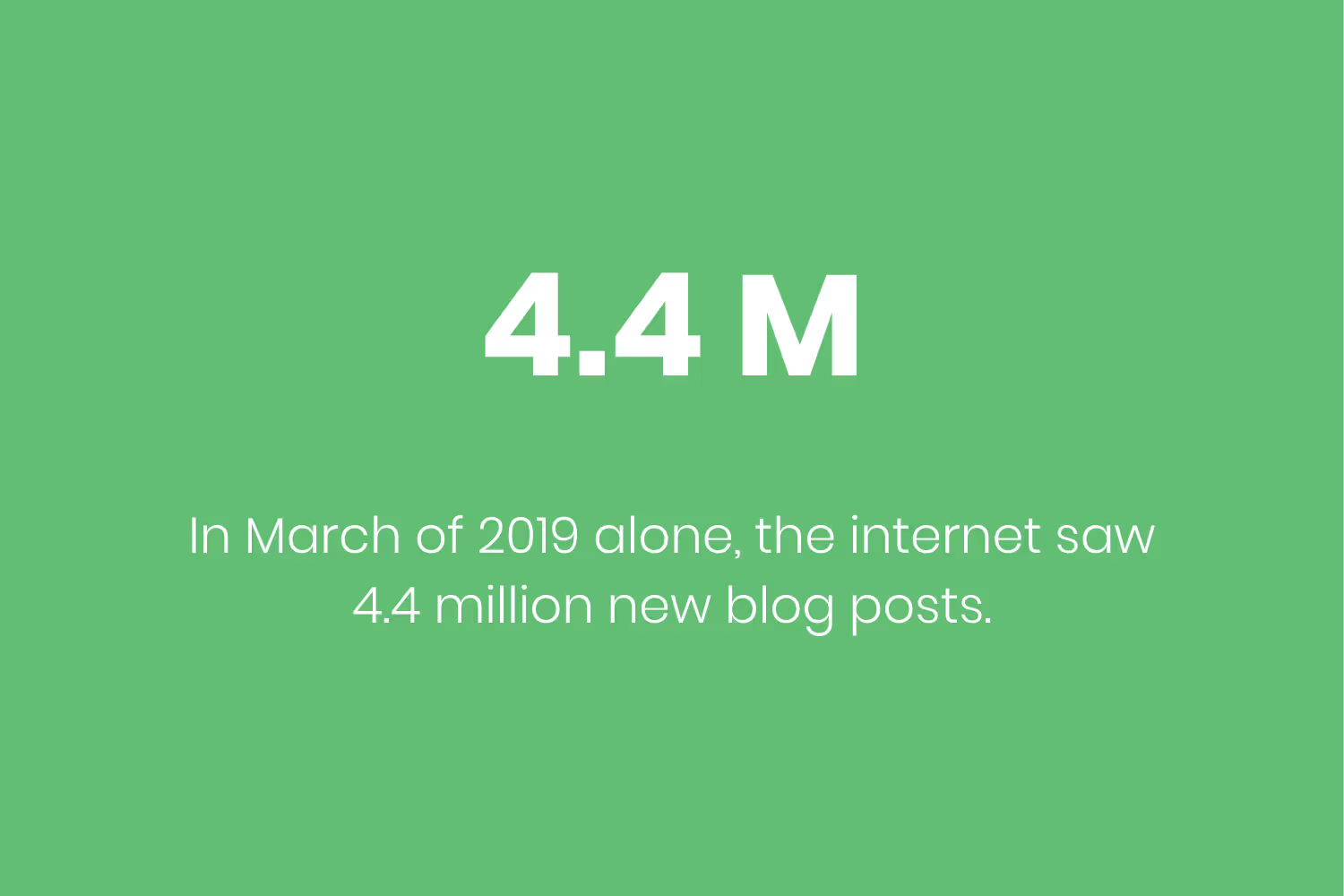
With that in mind, if you started writing posts about information that’s already covered by larger websites that get millions of visitors every month, the post you just spent hours writing would get lost in the saturation.
You might be wondering how a news article written by a news reporter vaguely covering a treatment plan ranks higher than what you wrote as an accredited healthcare specialist.
It comes down to what’s called domain authority.
Domain authority is a search engine optimization company’s fancy term for how Google views your website as a thought leader. It’s a score that ranges from 0-100, the higher the score the more influential and trustworthy Google views your website.
In other words, the website that generates traffic in the millions and wrote about the same thing you did will outrank you for the foreseeable future.
But by determining a niche for your blog, you’re establishing yourself as a thought leader faster because you’re spending so much time covering a specific, less covered topic.
Choose Easy to Rank for Topics
Let’s say you just recently updated your practice’s website. I’m sure it looks great and runs smoothly but you won’t generate any more traffic than you had before if you’re not providing anything valuable.
So, before you start writing anything you’ll want to brainstorm a few topics.
Let’s say you want to write about a topic on remedies for the common cold. You could probably list ten different over the counter or natural remedies that would help subdue symptoms of this illness right off the top of your head. That’s great and I’m sure the content you could provide would benefit quite a lot of readers.
However, the unfortunate problem is that your topic is highly competitive and, unless your website has a high domain score, you won’t rank within the first 10 pages of Google.
I’m not saying you can’t write about that topic. However, what I am saying is that you shouldn’t expect to gain any traffic from it. 75% of Google users never click past the first page.
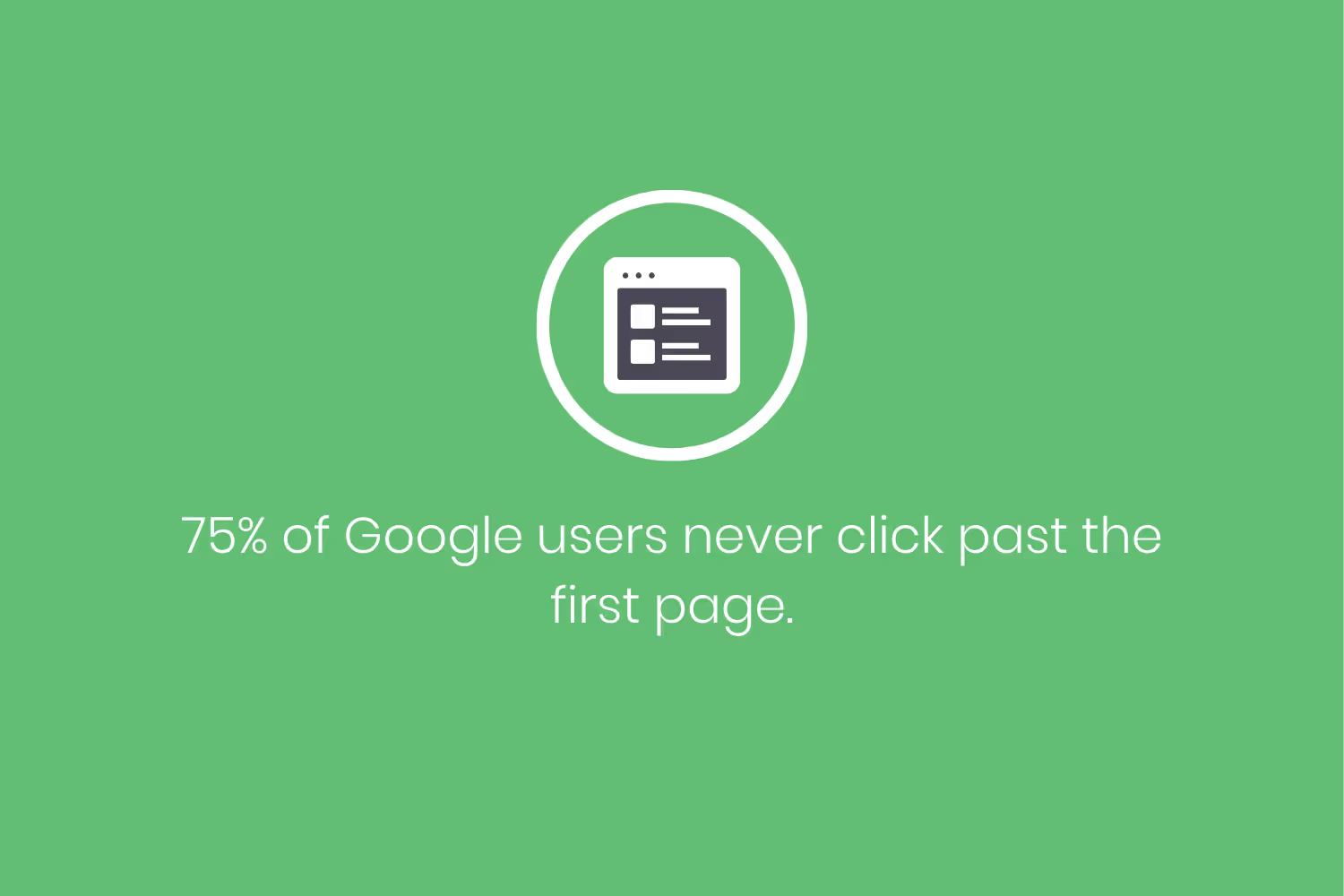
So, how do you determine what topics to write about?
Before you start typing away about topics you’re an expert about, do keyword research to find phrases that people are searching for and that are easy to rank on.
With that, let’s take the main topic from the example I gave earlier and see if there’s a similar topic you could write about that still gets a lot of traffic and you could land on the front page for.
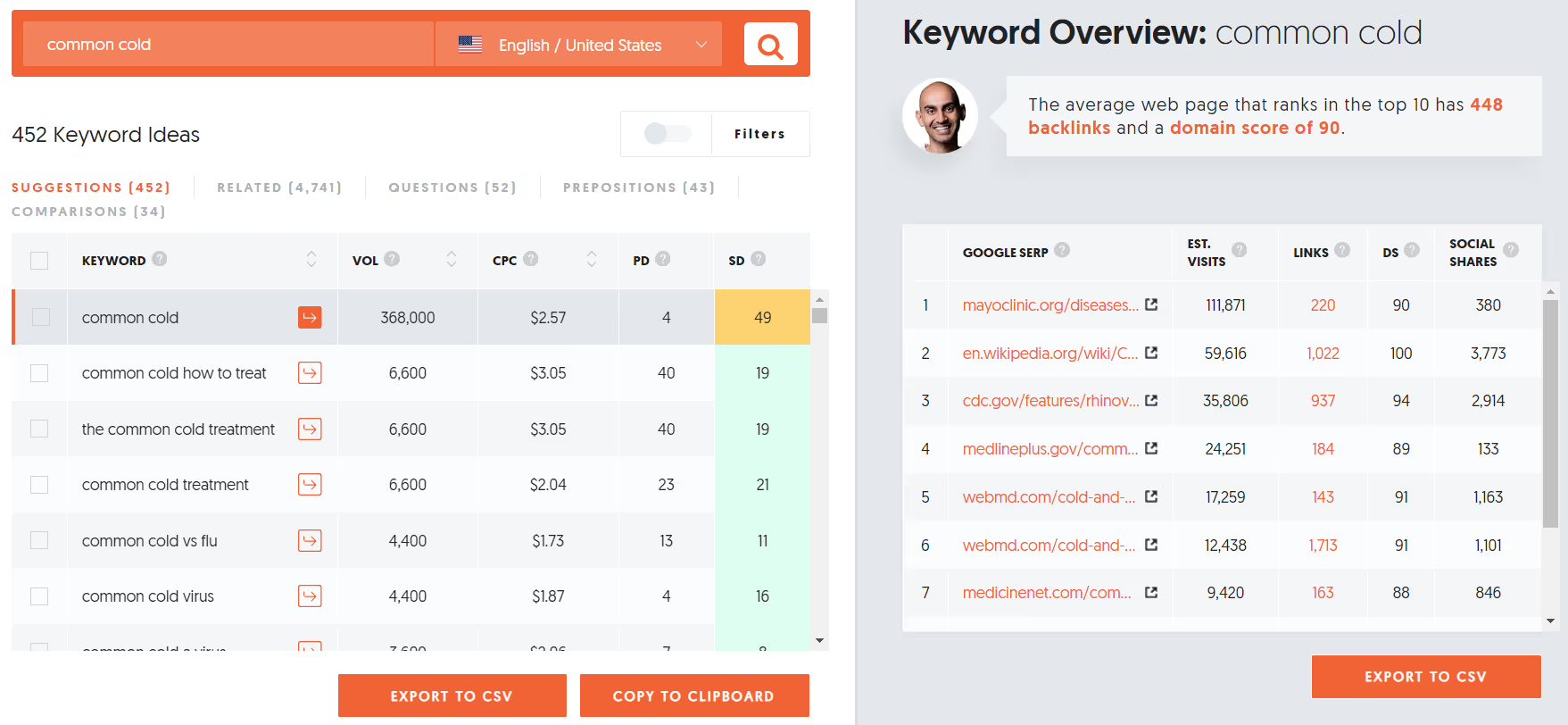
For this example, we’re using a service we pay for called UberSuggest. It’s one of many different keyword tools to choose from.
To use the tool, what you do is search for something like you would on Google. Here, we typed in “common cold” into the search box.
Once searched, almost 500 different related keywords and phrases populated on the left-most table. Listed at number one in the table is the main phrased we searched for on the left-hand side and a bunch of different metrics on the right.
The corresponding cells on the results table are the most important area because it tells you…
- How many times a phrase gets searched
- How much it costs per click for an advertisement
- Difficulty to land as the top listing for a paid advertisement
- Difficult to land as the top listing organically
Out of all of that information, the three most important columns to pay attention to and prioritize within these results are…
- Search difficulty
- Volume
- Keyword
Search difficulty deals specifically with organic search. Organic search is a fancy way of saying not paid. In other words, you don’t have to pay any money for your users to find your website if you’re listed for a particular keyword. Also, it lists a number between 1-100, similarly to domain authority, the higher the number the more difficult the keyword.
Volume has to do with how many times a keyword gets searched on a monthly basis. The more times a phrase gets searched for, the more potential for traffic coming to your website if you land on the first page of Google for that phrase.
The keyword is the word or phrase that you’ll want to base your entire blog post after. Instead of its technical term, look at these as “Topics” to make the concept easier to understand.
The table to the right of the results table shows the “live” results for the phrase you’ve selected. This is important because you can gauge the average domain score of the results to see if there’s a chance you’d rank with them.
OK, so what’s my point after all of this?
You want to write a blog post based on a keyword that has a low search difficulty, high volume, and not much competition.
So, let’s re-examine the same example from earlier now knowing what to look for.

The phrase “common cold” has a very high search volume but is extremely competitive. Its search difficulty is at a 49/100 which makes it near impossible to land on if you’re just now starting to blog.
Further evidence of its competitiveness is that the average domain score of all of the websites that currently list for this keyword is 90.
So, let’s scroll down on the results a little bit and see if we can find something else to use as the basis of our blog topic.
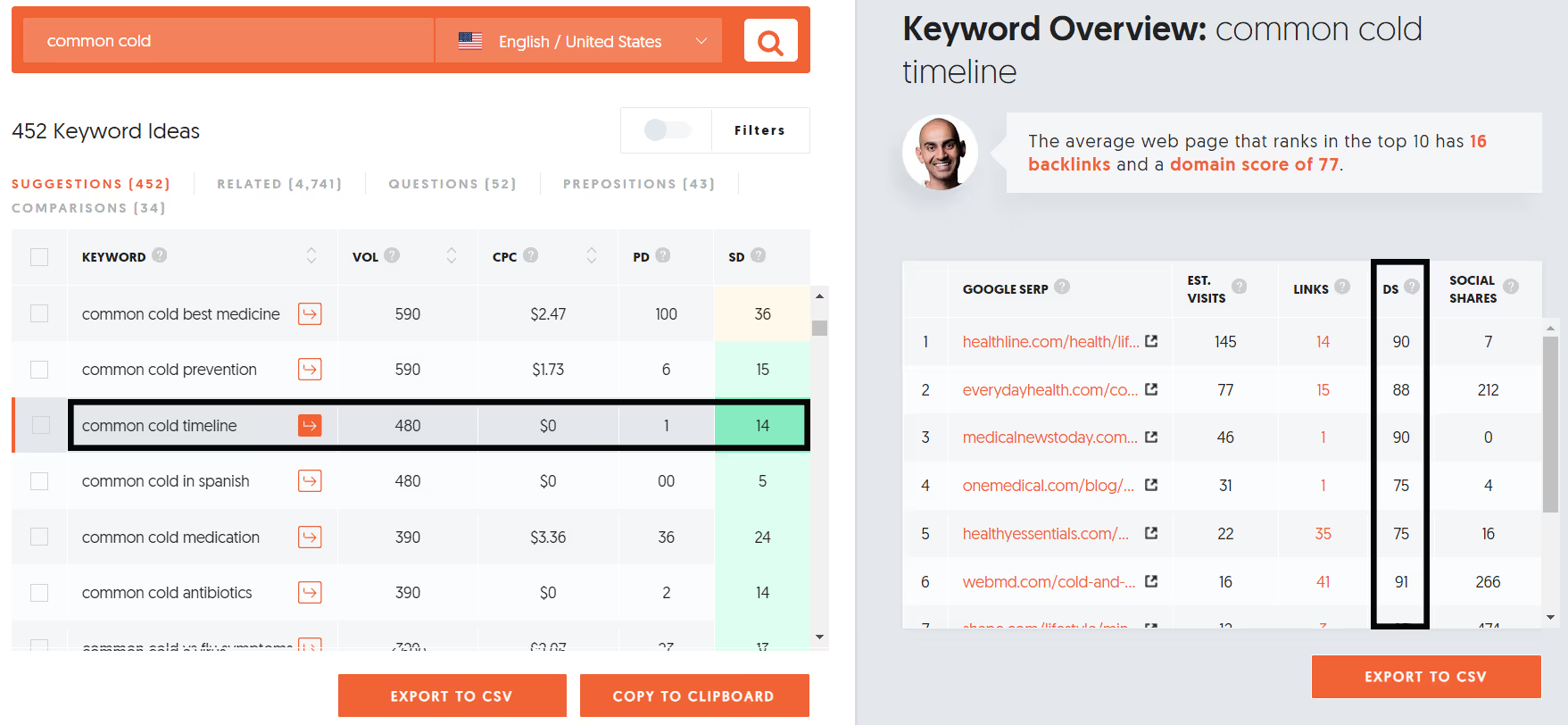
After scrolling down, I came across the phrase “common cold timeline.” This phrase was not only easy to rank for, it had a decently high volume as well.
It’s important to note here that when you’re looking for easy keyword phrases to land on, they’re not going to have nearly as much volume as some of the other, more popular ones.
That’s OK, any traffic to your website is good.
If you’re planning on taking healthcare blogging seriously, all of the traffic gained from each post you write builds up. Even if a phrase only generates 10 searches per month it’s still worth considering.
Tailor Your Writing to Your Audience
If you’ve made it this far you’ve probably noticed the casual tone I’ve used throughout this blog post. That’s no accident.
I’m using this tone because it makes the blog easier to read, regardless of who’s reading it.
When you’re writing anything on the internet, it shouldn’t be overly difficult to read. In other words, understand that you’re not writing a college thesis or submitting findings to a prestigious medical journal.
Instead, think about who you want to read your healthcare blog. If you’re writing for patients, then you should make sure your copy is understandable by the masses.
One of the best examples of good content written in an understandable form is Ernest Hemingway’s The Old Man and The Sea. This is one of the greatest pieces of American literature and it’s written at a fourth-grade reading level.
But how do you figure out what reading level your blog post’s copy is at?
Use the tool, Hemingway.
I’ve spoken about this tool in a different blog post about patient education materials but it’s such a helpful tool that I need to reference it again here.
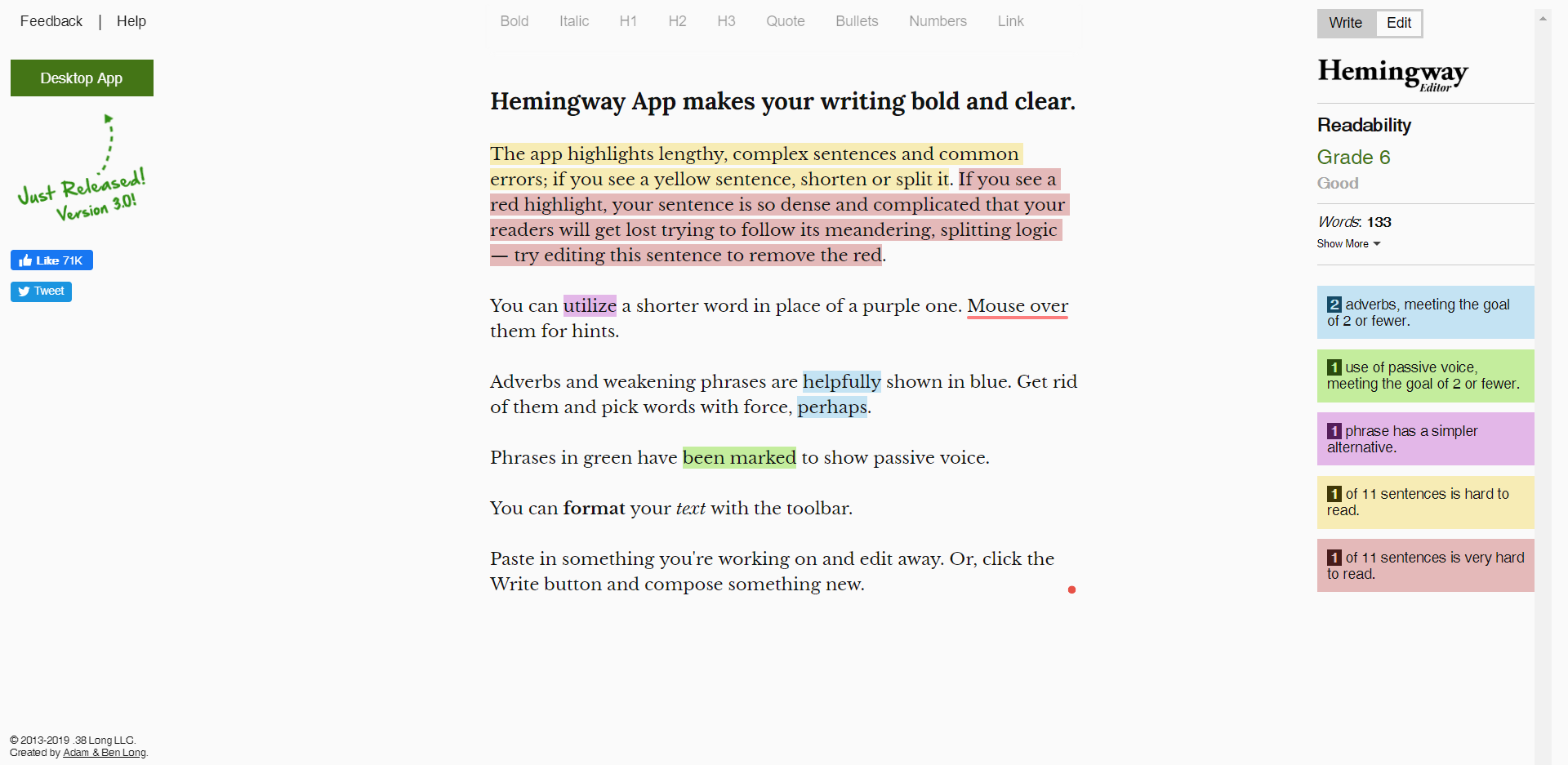
When you copy and paste your copy into this tool, it gives you real-time feedback. On the top right, it tells you the reading level of your blog post. This score exists based on the multi-colored criteria below.
The tool also highlights your copy based on the different criteria so that you can go back and edit it as necessary.
To determine what reading level is the best for the masses, look at what newspapers do. Most newspapers write between a 9-11 grade reading level.
You want to make sure that you’re not over-simplifying your copy either. You don’t want your target audience to get offended by your blog posts because they’re so dumbed down.
Out of all of the criteria listed within the Hemingway tool, you should focus on passive voice. Avoid passive voice at all costs. It has the biggest impact on your readability score and it’s generally looked at as a poor writing technique.
Give it Time
After you’ve launched your healthcare blogging expedition, you’ll want to see results right away.
The only problem with that is ranking on search engines takes time, especially if you’ve just started.
It could take anywhere from the first couple of hours to 720 days to rank on the first page of Google.
Let’s look at one of our own blog posts as an example.
We published our post Chatbots in Healthcare: How They're Changing an Industry in November of 2019.

It’s a comprehensive piece of content that covered some of the coolest up-and-coming healthcare-related chatbots.

It is a great blog post (not to brag) but it took Google a full seven months to figure that out as well.
Over the course of those months, the page continually started to gain traction and move up in ranks as you can see by the chart above. However, it didn’t really start to gain traffic until it hit the front page during the month of May.
You can’t directly control how long it takes search engines to realize your content is great, it takes web crawlers time to find that out.
However, you can influence it using Google Search Console.
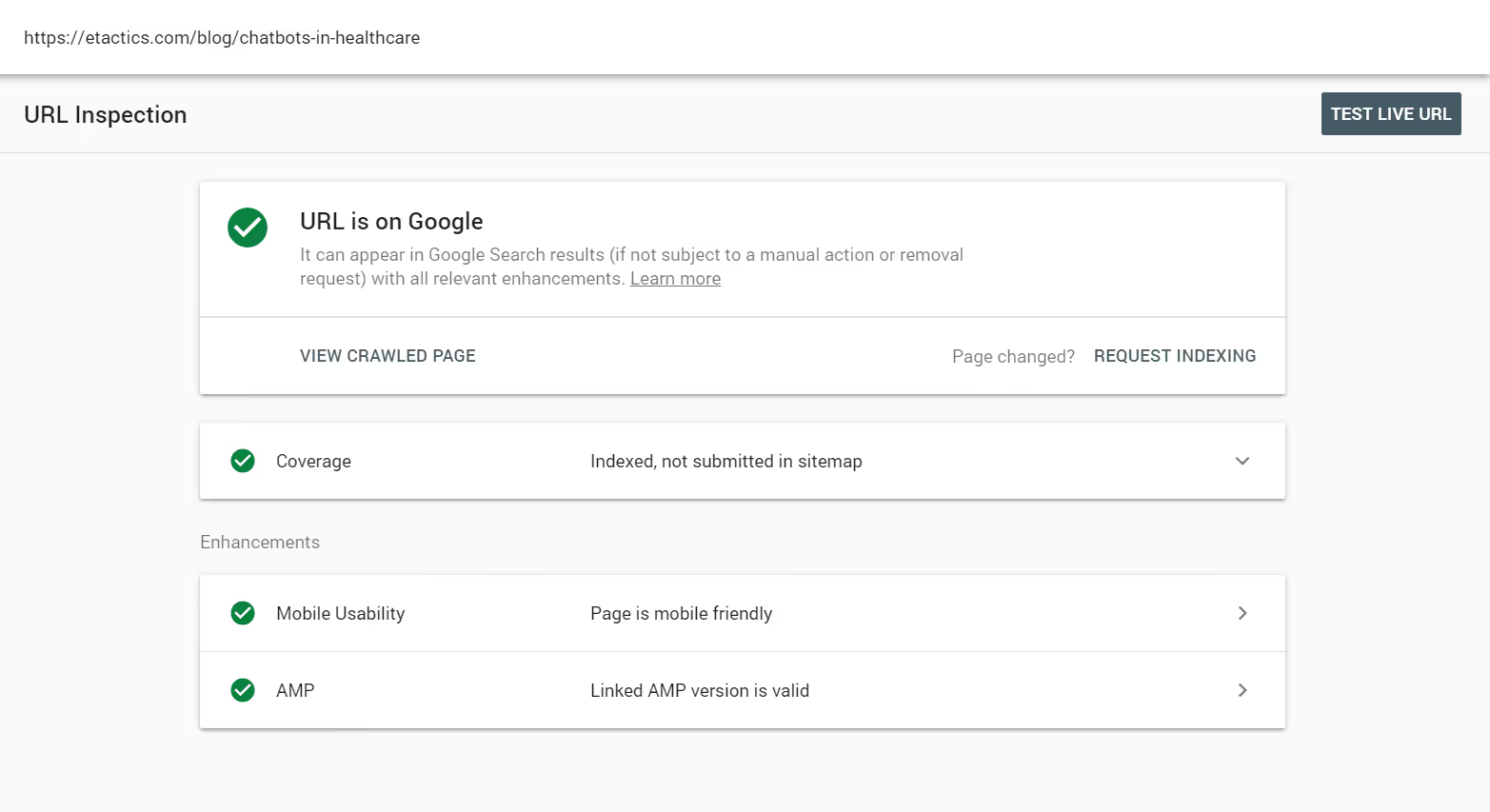
If you haven’t already set up this tool, do so as soon as you can. It’s like Google Analytics but it monitors their web crawlers and allows you to influence them.
Once you’ve published your blog posts, navigate to this tool and search for the URL you just created in the search box at the top.
From there you’ll navigate to a page that tells you whether or not your blog post is on Google.
If you just published something, it’s not going to have a listing right away.
This is the page where you can let Google know what to crawl. From here, click on the “REQUEST INDEXING” button near the top. Clicking this button tells Google’s bots to prioritize this webpage.
Going through Google Search Console doesn’t guarantee that your blog post will land on the first page right away but it definitely speeds up the process.
Make Connections for External Opportunities
As you write more blog posts two things will happen. First, you’ll obviously gain more traffic through your organic listings. Second, you’ll get backlinks to your website.
Backlinks are a form of gold in the search engine optimization (SEO) world.
They help boost your domain score tremendously because Google looks at them as a form of a different website vouching for yours. In other words, when someone links back to one of your blog posts as a source they’re saying that the information you provide is credible.

Backlinks will naturally increase over time the more you blog.
However, you can also influence getting backlinks by writing guest blog posts.
Guest blogging is a strategy many marketers use to reach into other audiences and while inadvertently increase their own website’s domain authority.
All you have to do is research other blogs that relate to your industry and reach out to them with a content idea.
While you’re writing your guest blog, add links back to your posts on your website. It’s an easy strategy that boosts your online presence tremendously.
As a doctor or healthcare professional, you have knowledge on some of the most sought after information. This means that finding guest blogging opportunities isn’t going to be difficult for you.
To start, go to your favorite search engine and type in a topic you’re an expert in with the added phrase “guest blog submission” at the end.
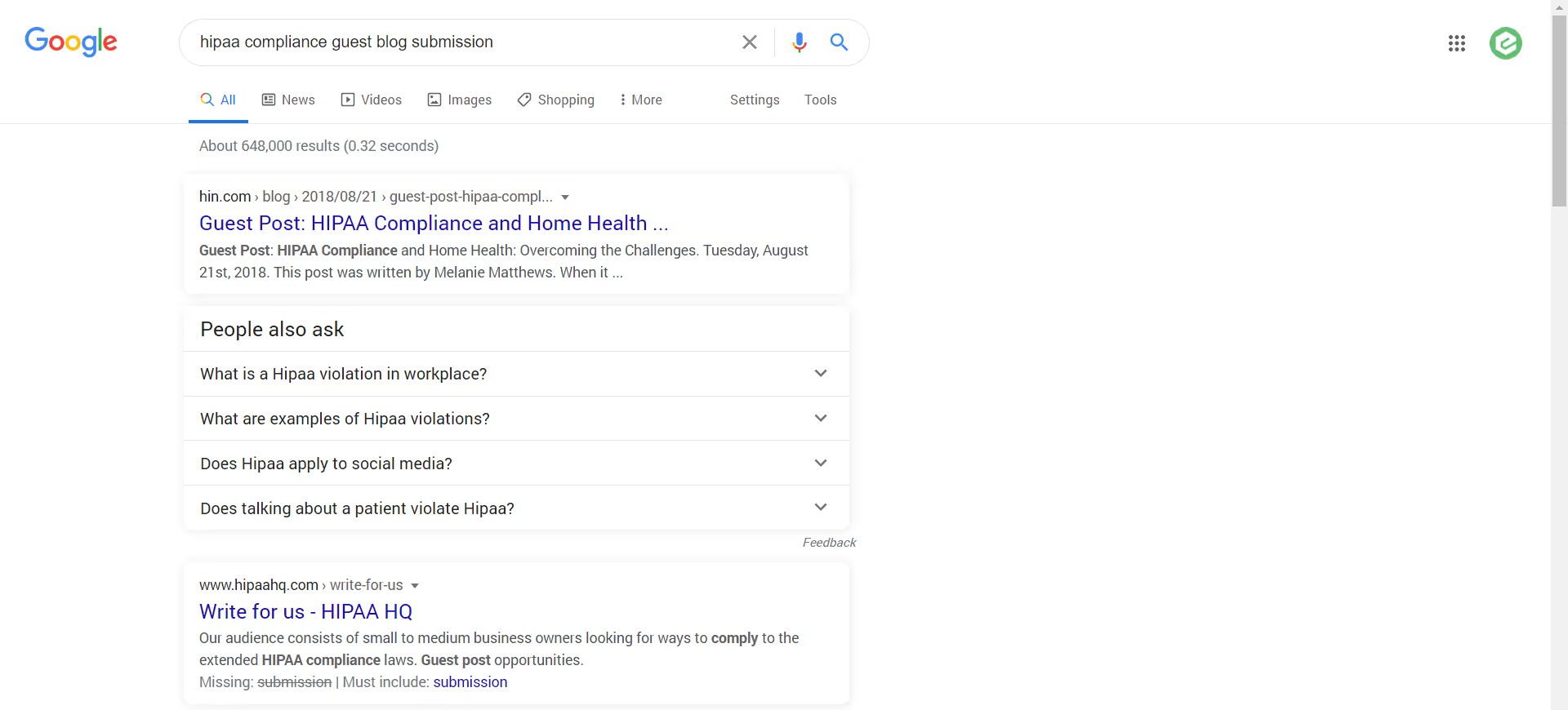
I went through this process to provide you with an example and it took me three seconds to find a website that’s accepting guest blogs (the second result in the image above).
Conclusion
Deciding to create a blog and design a strategy around it is a big undertaking.
However, it’s one of the most effective ways to gain traction for your practice without spending a lot of money upfront.
It further establishes you as a modern healthcare leader that not only understands the intricacies of the medical industry, but also as one who stays up to date with the most current trends.
After reading this blog post, you’re ready to start. Now it’s just a matter of when. The sooner you start your healthcare blogging, the quicker you’ll see more traffic on your website.
Emphasize your product's unique features or benefits to differentiate it from competitors
In nec dictum adipiscing pharetra enim etiam scelerisque dolor purus ipsum egestas cursus vulputate arcu egestas ut eu sed mollis consectetur mattis pharetra curabitur et maecenas in mattis fames consectetur ipsum quis risus mauris aliquam ornare nisl purus at ipsum nulla accumsan consectetur vestibulum suspendisse aliquam condimentum scelerisque lacinia pellentesque vestibulum condimentum turpis ligula pharetra dictum sapien facilisis sapien at sagittis et cursus congue.
- Pharetra curabitur et maecenas in mattis fames consectetur ipsum quis risus.
- Justo urna nisi auctor consequat consectetur dolor lectus blandit.
- Eget egestas volutpat lacinia vestibulum vitae mattis hendrerit.
- Ornare elit odio tellus orci bibendum dictum id sem congue enim amet diam.
Incorporate statistics or specific numbers to highlight the effectiveness or popularity of your offering
Convallis pellentesque ullamcorper sapien sed tristique fermentum proin amet quam tincidunt feugiat vitae neque quisque odio ut pellentesque ac mauris eget lectus. Pretium arcu turpis lacus sapien sit at eu sapien duis magna nunc nibh nam non ut nibh ultrices ultrices elementum egestas enim nisl sed cursus pellentesque sit dignissim enim euismod sit et convallis sed pelis viverra quam at nisl sit pharetra enim nisl nec vestibulum posuere in volutpat sed blandit neque risus.

Use time-sensitive language to encourage immediate action, such as "Limited Time Offer
Feugiat vitae neque quisque odio ut pellentesque ac mauris eget lectus. Pretium arcu turpis lacus sapien sit at eu sapien duis magna nunc nibh nam non ut nibh ultrices ultrices elementum egestas enim nisl sed cursus pellentesque sit dignissim enim euismod sit et convallis sed pelis viverra quam at nisl sit pharetra enim nisl nec vestibulum posuere in volutpat sed blandit neque risus.
- Pharetra curabitur et maecenas in mattis fames consectetur ipsum quis risus.
- Justo urna nisi auctor consequat consectetur dolor lectus blandit.
- Eget egestas volutpat lacinia vestibulum vitae mattis hendrerit.
- Ornare elit odio tellus orci bibendum dictum id sem congue enim amet diam.
Address customer pain points directly by showing how your product solves their problems
Feugiat vitae neque quisque odio ut pellentesque ac mauris eget lectus. Pretium arcu turpis lacus sapien sit at eu sapien duis magna nunc nibh nam non ut nibh ultrices ultrices elementum egestas enim nisl sed cursus pellentesque sit dignissim enim euismod sit et convallis sed pelis viverra quam at nisl sit pharetra enim nisl nec vestibulum posuere in volutpat sed blandit neque risus.
Vel etiam vel amet aenean eget in habitasse nunc duis tellus sem turpis risus aliquam ac volutpat tellus eu faucibus ullamcorper.
Tailor titles to your ideal customer segment using phrases like "Designed for Busy Professionals
Sed pretium id nibh id sit felis vitae volutpat volutpat adipiscing at sodales neque lectus mi phasellus commodo at elit suspendisse ornare faucibus lectus purus viverra in nec aliquet commodo et sed sed nisi tempor mi pellentesque arcu viverra pretium duis enim vulputate dignissim etiam ultrices vitae neque urna proin nibh diam turpis augue lacus.


.avif)

